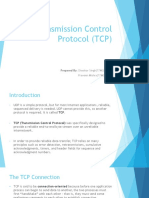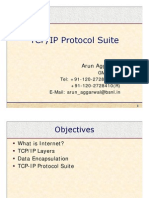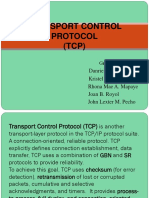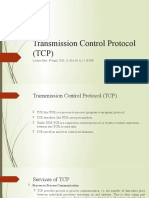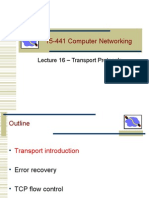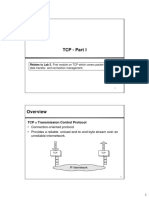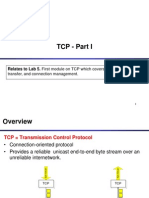0 ratings0% found this document useful (0 votes) 19 views16 pagesCN Unit 4
Computer network handwritten notes
Copyright
© © All Rights Reserved
We take content rights seriously. If you suspect this is your content,
claim it here.
Available Formats
Download as PDF or read online on Scribd
�UNITS
Transport Layer
@> dota is in form of segments
ayer
Segmentation and Regssembly
> sevies 7
Procees +0 Procecs delivery
addressing
cP
upP
NH Plexing ® Deraultiplexing
JTAWA_Ranges
mber_ Awihori
divided porn into 7 en roof
\L_5 Registered ports 1024 -4915]
Dynamic forts 4959 - 65535
s
Or nO-
eB TELNET (Teletype Nutwork Protocoty)
m_ 7 SMTP CSimpe mal «= Fea. prooed)
— BNS Coma Nanwe sewer)
— _ 80 Wire C Hype xt transfer Protovt _
— Rec (Remote Proeedive Coed
2 ETP, Data, Wnrtcton
AL ETP Com Wonrection
Sater Addresses
> Combination of qT Addiess _and_o_port number�PP Sonnectionless
ie. F700 OCKNowledg ement-
\ano- error @ Flow Contre}
UDP Header formot
8 Bytes
UDP Header UDP Data
Source port Destination port
16 bits 16 bits
Length Checksum
16 bits 16 bits
\iDP_ Operations
* ConneCtionless Services
+ No Flow and Error Control
+ Eneepsulletion and _Decabsulation
At the client site, when a process starts, it requests a port number from the operating
system.
The client process can send messages to the outgoing queue by using the source port
number specified in the request.
UDP removes the messages one by one and, after adding the UDP header, delivers
them to IP.
When a message arrives for a client, UPP checks to see if an incoming queue has
been created for the port number specified in the destination port number field of
the user datagram.
When a message arrives for a server, UDP checks to sce if an incoming queue has
been created for the port number specified in the destination port number field of
the user datagram.�P is suitable for a process that requires ¢iRieMTv est SpAReEDAEmunication with)
It is not usually for a process such as FTP
_ that needs to send bulk data.
“UDP is suitable for a process withiintenal Mow and error Control mechanisms)
UDP is a suitable transport protocol {otramicantne Multicasting capability is embedded
in the UDP software but not in the TCP software.
-UDP is ised for management|/processes| SUCH/AS|SNMP) (Simple Network Management
Protocol).
-UDP is used for some route updating protocols such as Routing Information Protocol.
Tce Services.
D) Process 4o_Procece Communication
-> TCP provides _process-to-process _Communicution using port
DUNT.
-2)_Stream_Delivery Seiyice
@, TCP Allows, the sending process to deliver date _os_a
Stream_of byte and allows the feceiving process to
Obtain data qs @ skeqm of pyle.�? jornms in whi SSCS
ony bi imaginary _“sqbe™ that
Caries their_daty across the_internes
Wor Quer _| 10> connection Grienks protocol
_STCP_OfFIS Ful\-dublex Setvice, in which dota can Slow in
Airections ime.
(B) > Each TCP then hos a Sending and receiving buffer, and
S i iret
4 Connection Oriented Service.
When o as $ d ecene
from _onother_pracese_at site B, the following _octurs
q) Two _TCP_establich _a_connection between them�5) Dea Gre exchanged in both directions
© The connection is terminated .
8) Reliable _setvice
> it ses Gn_ckpowledgment mechanism to check she sc
gna Cound _crrival_of date.
TCP Features
Numbering System
There are two fields called the sequence number and the acknowledgment number. These
two fields refer to the and not the segment number.
Byte Number
The
numbering starts with a randomly generated number.
Acknowledgment Number
The value of the acknowledgment field in a(segmentdefines the numberof the next bytea)
party expects to receive.
Sequence Number
After the bytes have been numbered, TCP/@Ssigiis @S€quenéelHUMbEPto each segment that
is being sent. . o
32 bits
TCP Segment formay |
@ Source port # IgbbitS Dest port # (6 bi
Sequence number 2.9 bide
Acknowledgment number 22 bifS
Header GBS Ovzize
Szne ews
: jength Unused SLE BEE | 15) (Receive window
4urs
Intemet checksum |¢44¢ Urgent data pointer 14.4.
Cptions (0-40 bye)�Source port address: This is a 16-bit field that defines the port number of the the host that
is sending the segment.
Destination port address: This is a 16-bit field that defines the port number of the the host
that is receiving the segment.
Sequence number: This 32-bit field defines the number assigned to the first byte of data
contained in this segment.
Acknowledgment number: This 32-bit field defines the byte number that the receiver of
the segment is expecting to receive from the other party
Header length: This 4-bit field indicates the number of 4-byte words in the TCP header.
The length of the header can be between 20 and 60 bytes. Therefore, the value of this field
can be between 5 (5 x 4 =20) and 15 (15 x 4 =60).
Reserved: This is a 6-bit field reserved for future use.
Control: This field defines 6 different control bits or flags
Rog Dereripiion
URG Me value g unger poirtnr Hud ts Vored.
Au. Me Vorut OF Ocpnrowldazmunt Hud ¥s VoRtd.
(sn 2 . ah te Dato
@sT Reret Conrchon
rt : - duane
Syn oe dae Sequence no. eg
FIN Tenminoke tonrettow
Winé6w size: This field defines the size of the window, in bytes, that the other party must
maintain. Note that the length of this field is 16 bits, which means that the maximum size
of the window is 65,535 bytes.
Checksum: This 16-bit field contains the checksum.
Urgent pointer: This 16-bit field, which is valid only if the urgent flag is set, is used when
the segment contains urgent data.
Options: There can be up to 40 bytes of optional information ®
TCP_Connection�2Compection Esiqbhishmen — Thee way Hondshoking Cull duplex Mode)
TCP connection establishment ( Three way handshake)
Sl Client Server _—
—_ en SHE ‘lent —_
_ stg 69. SE ‘ene +11 SEQ. Server
—_ oe ee amy _,
1ONOS ‘SEQ. = Sequence number
Tad Piggybactsing »Data_and acknowledgment. send ck ch
Data Transfer Somme tie 4hiS yeduces Netaark HCFC.
Pure acknowledgement» +¢ you_don+ have dais
4o_ send @) time our then send only
Acknowledgement.
~> Connection Termination » when di) data iS send ct Client Side.
Half-close > client 4o Server cotnechon is over, Dara Can4
be send ftom client to sever, Ock can be send
Elow \_in T
> The receiver of the data Continjs the Omount Of data that
is +o be gent by the ender,
> This_cone 49 prevent: _the receiver from being overwhelmed _with�Numbering System we TCP +o We -
Flow contol.
Exror_contro)
> TO provide feliable_cervice itmplemer r fol
Techonismn.
Use 7? checksum
\— Acknowled gement
ime -oy+
Congestion Control ore data overflow +o [outer |
> mount= ra Sent nrre\}
ty the_teceiver but ic_also ea by the _level_of
congtstion in the network.
Congestion Policy
J) Slow_start
> Exponential ‘Increase
> The Size of the window incteages one MSS each me an
__aeknowredgment is received.
Wi v s_exbonenhall
congestion window Size
stat ———> _ Cw = =4
After Round | ————> cynd = 9=2�Aer Round 29 ———> cund= r= 4
After Round 2 ————> Cwnd = 9? = &
> additive increase
> _Th this algorithm, each time the whole. Window GF Segments
S__Aeknowledged Cone round!) , the site of the congestion
Sut ——» Cwod= 4
oft Rowndt ———> Cwnd = 2
after Round 2. ————F_ (wd = 3
atier Round 3 ———> cwnd = 4
2) Congestion _Detechon
nyse mas cregee.
> EF Congestion occurs , the congestion window size must be.
decreased. . _
IF deletton is by time-olt+ 5 @ NEW Slor-
i Start
> con _be implemenied a¢ | i phase StS
Gif deection is by thee ACKS) a reW
Congestion GVoidance “phase Starts -
QUALITY OF SERVICE
‘Quality of service (QoS) is the use of mechanisms or technologies that work on a network
toonrl ats eritcal applications wih limited network
capacity.
TECHNIQUES TO IMPROVE QoS@)
© Scheduling
©. Traffic Shaping
Resource Reservation
© Admission Control�in
> PacketS from differnt flows Gtrive Ota Switch or rower
for processing.
iques e_ GifFerent- is in
q_fair_and Qpplopriae manner.�vs
D 5
IN Waight 1
Sull2 N LL}
D
9 Traffic. Shaping
> iS q Mechanism fo Contel the Gmounr Ghd the me of
the traffic gent +9 “the network
#2 Leoky Bucket
—inprr mle can vary, but the utbur ite femaing Coneanr.
| 7 Busty Flow
unregulated
12 Mops
Deooss
6
i 3 Mbps
2
| Regutated
Flow Fixed Flow 01294567 8910
Fixed Data —@~
(S 400 Fast bez of whicl
Bucket capacity is Full, then�Aatd will be discarded.
b> Token Bucker
-allows idle host +o Qccumulare Credit for the furnre
| in the for Ss. for ick OF the clock.
SySitm_sends token +0 the bucket
~The _sysiem removes One token for every Cell Cor be)
of dota sent.
— Fill bucket with tokens
a at constant rote
V Proceed request if tokens available in bucket
Request and remove consumed token From bucket
ES Ge
\ Drop request
# bucket is empty,
3 jr
flow of du Ices Such as bi bandwidth,
CPV Time Gnd So on
> ality of Servi is impmved if these ees.
Gye (eServed beforehand.
4) Admission Control
> felis to the mechanism used by @ router, ora�Switch, +0 _QCepr _Or_ reject a “How based _on_predetined
parametis Called Slow _ specification.
> totter Qceepts, a Flow for processing, it checks the
Slow__speciffention to __see_if its capacity and its
Previous Commit ments
®
PYQ
1) The following is the dump of a TCP header in hexa-decimal format: 10M 2018-2019
05320017 00000001 00000000 500207FF 00000000
(i) What is the sequence number? Sounee & Dear. Pork Add - 2Hybes
(ji) What is the destination port number? S27 & ace no.- 4 -
(iii) What is the acknowledgement number? 4 > Sword. Resrved= 6 tals
(iv) What is the window size? Comtrat = 6 bes Window size: 2 Byte
neat ome = Nei WM Fotwier= 2 ayes
Sov) TCP Heager_Diagrarn
05359 001% Hog0ndar Od000000 Sanzd4Fe 06000000
io
{0000-01045 Bye 0000-9
eat fx. digit = 4 Bits
) source Port odd. = 2 Byles > 0532
2) Destination fort Add. = Byes > OOIF
3) seq no. = 4Byke > 00.00.00 01
¥) ack. 0. = 00000000
5 Hien = 4 word =4 Bits = S
. * tT
6) Reseried_bits = $ Bits = Qno00d�D Cnin = Css = Mooi
8) Window size = 9 nye = OFFF
=_2 ByRS = 0090
\o) Urgent Pointer = Q8}4es = 9000�




















